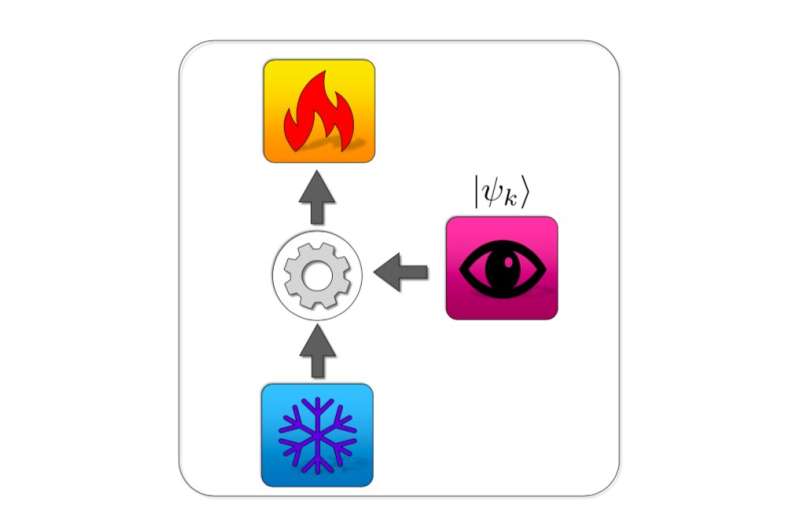March 11, 2019 feature
Using quantum measurements to fuel a cooling engine

Researchers at the University of Florence and Istituto dei Sistemi Complessi, in Italy, have recently proved that the invasiveness of quantum measurements might not always be detrimental. In a study published in Physical Review Letters, they showed that this invasive quality can actually be exploited, using quantum measurements to fuel a cooling engine.
Michele Campisi, one of the researchers involved in the study, has been studying quantum phenomena for several years. In his recent work, he investigated whether quantum phenomena can impact the thermodynamics of nanoscopic devices, such as those employed in quantum computers.
"Most colleagues in the field were looking at coherence and entanglement while only few were looking at another at genuine quantum phenomenon, i.e., the quantum measurement process," Campisi told Phys.org. "Those studies suggested that you need to accompany measurements with feedback control, as in Maxwell's demon, in order to exploit their potential. I started thinking about it, and eureka—since quantum measurements are very invasive, they are accompanied by energy exchanges, hence can be used to power engines without the need to do feedback control."
The second law of thermodynamics states that heat naturally flows from hot bodies to cold ones. Past studies found that there are two ways to reverse this natural flow of heat: using work supplied by an external, time-dependent driving force or by implementing a Maxwell demon, which steers the heat via a feedback control loop.
In their study, Campisi and his colleagues showed that there is, in fact, a third method to reverse the flow of heat, which is based on quantum mechanics. This technique entails the use invasive quantum measurements as a fuel that powers refrigeration, without any feedback control. The researchers refer to this mechanism as quantum measurement cooling (QMC).
"The general mathematical framework is standard quantum mechanics, but we had to use a mix of advanced numerical and analytical methods to investigate all facets of quantum measurement cooling," Lorenzo Buffoni, another researcher involved in the study, told Phys.org. "For example, in order to assess its the robustness to experimental noise we used extensive Monte Carlo sampling of the high-dimensional space of possible measurement projectors, and used machine learning techniques to analyze and visualize the data."
Campisi and his colleagues illustrated QMC by means of a prototypical two-stroke two-qubit engine. This engine interacts with the measurement apparatus employed by the researchers, as well as with two heat reservoirs set at different temperatures.
"We also embarked on the task of finding the optimal thermodynamic performance by analytical methods, which was very challenging," Andrea Sofanelli, another researcher who carried out the study, told Phys.org. "We employed Birkhoff theorem to express the so-called transition matrix (containing all relevant information about the energy exchanges in our problem) in terms of permutations, which simplified the problem. But we remained stuck with that until we found a little-known theorem of linear algebra dating back to the early 1990s, which finally led to the solution."
Campisi, Buffoni, Cuccoli, Solfanelli and their colleague Paola Verrucchi demonstrated that the invasiveness of quantum measurements can be used to fuel a cooling engine via the QMC mechanism they have reported. QMC does not require feedback control, but entanglement must be present in the measurement projectors.
The researchers calculated the probability that QMC will occur when the measurement basis is randomly selected. They found that this probability can be very large compared to the probability of extracting energy (i.e. operating the heat engine), yet it is smaller than the probability of the least important operation (i.e. dumping heat in both baths).
"Showing that measuring a quantum system made by two qubits can produce by itself (i.e. without feedback control) useful thermodynamic effects surely represents the most meaningful outcome of our research," Alessandro Cuccoli, another researcher involved in the study, told Phys.org. "This follows from looking at the quantum measurement process from a wider perspective, where both the system and its environment, and the energy exchanges accompanying the measurement, are considered."
According to Cuccoli, the two-quibits thermal engine developed by the researchers could easily be engineered to work as a cooling device. This would, among other things, enable the fabrication of a quantum computer's processing units to be integrated with auxiliary devices that can keep them at the required low temperature, as both can be achieved using qubits.
"A further insightful observation is that in order to get useful thermodynamic effects, the measurement process has to involve 'entangled' states, i.e. peculiarly quantum correlated states of the two qubits, thus revealing the intimate connection between information and energy exchanges," Cuccoli added. "Deepening our understanding of such relationship in nanoscopic quantum engines is one of the major challenges driving our current and future research in the field of quantum thermodynamics."
The study carried out by Campisi, Buffoni, Cuccoli, Solfanelli and Verrucchi introduced an entirely new mechanism that can reverse the natural flow of heat, intervening with the second law of thermodynamics, without feedback control requirements. In the future, their findings could have many applications, for instance, aiding the development of devices to cool quantum computers.
The team of researchers involved in this study is part of a collaboration consortium that involves 12 world-class research groups, including experimentalists and theorists from eight E.U. countries. They are currently seeking the resources necessary to support their work in the forthcoming years.
"We are looking forward to collaborating with experimental groups that might be interested in building a functioning quantum-measurement cooler," Campisi said. "The full understanding and mastering of the energetics of quantum systems and devices is urgently needed, and calls for a joint international effort in order to speed up technological development."
More information: Lorenzo Buffoni et al. Quantum Measurement Cooling, Physical Review Letters (2019). DOI: 10.1103/PhysRevLett.122.070603
Journal information: Physical Review Letters
© 2019 Science X Network




















